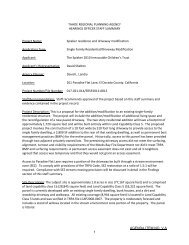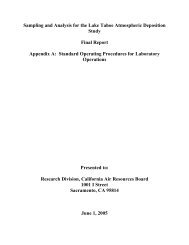FEIS - Tahoe Regional Planning Agency
FEIS - Tahoe Regional Planning Agency
FEIS - Tahoe Regional Planning Agency
Create successful ePaper yourself
Turn your PDF publications into a flip-book with our unique Google optimized e-Paper software.
RESPONSE TO COMMENTS ON THE DEIS<br />
B o u l d e r B a y C o m m u n i t y E n h a n c e m e n t P r o g r a m P r o j e c t E I S<br />
reader. The calculations that were performed are summarized in Tables 4.3-5 through<br />
4.3-12. DEIS Appendix G provides the supporting data. The data that were used are<br />
based on the contributing areas, impervious surface areas, and the treatment<br />
capacities proposed. These numbers and calculations vary in accordance with the<br />
characteristics of the Alternative. The LID strategy assumptions used for the<br />
calculations are outlined in DEIS Appendix R.<br />
Comment 335-ab: Comment Summary - App. P should describe the certainty of the estimates based on<br />
the limited sampling, and how the events compare to 20-, 50-, and 100-year events.<br />
DEIS Appendix P presents the results from the pre-project monitoring completed for<br />
purposes of characterizing the existing conditions of the project area and to<br />
appropriately design and size the proposed stormwater treatment systems. The storm<br />
events are summarized on pages 4.3-5 to 4.3-7 of the DEIS and detailed in Appendix<br />
P.<br />
Comment 335-ac: Comment Summary - Clarify fine sediment sampling methods and results.<br />
As stated in DEIS Appendix J and reiterated in the DEIS hydrology analysis, the<br />
loading estimates should be used with caution because of the small sample size. See<br />
Appendix AB for supplemental surface water quality analysis that further supports<br />
the level of impact conclusions for HYDRO-1 and HYDRO-3. Automated samplers<br />
are not currently installed. The range is large because the loading estimates are<br />
presented by "event basis", meaning that 253 lb/day was measured for one storm<br />
event and 9,947 lbs/day was measured for a separate event. The range provided in<br />
the DEIS states the range calculated for the 6 events. See Appendix AB for annual<br />
loading estimates. The 34,450 lbs/yr is within the predicted range of 12,245 lbs of<br />
total sediment in a dry water year (1993-94) to 52,825 lbs of total sediment in a wet<br />
water year (1994-1995). Additional estimates for other water year scenarios are listed<br />
in Tables 2 and 3. The fine sediment analysis for the events did differ slightly as<br />
explained in the JBR report. There is no codified regulation that requires analysis of<br />
fine sediment at this time. The analyses were completed voluntarily to characterize<br />
the project area and appropriately design and size stormwater treatment systems.<br />
Comment 335-ad: Comment Summary - Define the terms "effective coverage", "Minimum capacity<br />
(TRPA Coverage): 100% of 50-year/1-hr storm” and “Minimum Capacity (TMDL<br />
Reduction Coverage): 100% of 100yr/1hr storm" in relation to TRPA and other<br />
agency regulations.<br />
As stated on page 4.3-29: Effective coverage is defined as subset of total impervious<br />
area that is hydrologically-connected via sheet flow or discrete conveyance to a<br />
drainage system or receiving body of water (Washington State University 2005). This<br />
is a standard term used when discussing strategies for direct reductions in runoff<br />
contributions or attenuation of peak runoff volumes. TRPA does not regulate<br />
effective coverage. Assuming that the commenter is referring to DEIS Appendix R,<br />
Minimum Capacity (TRPA Coverage) means based on TRPA defined land coverage<br />
and Minimum Capacity (TMDL Coverage Reductions) means that LID effective<br />
coverage reductions are included. The calculations in support of the 100yr/1hr storm<br />
volume capture are summarized in Table 4.3-12.<br />
Comment 335-ae: Comment Summary - Provide data supporting the performance of pervious pavement,<br />
the sweeper plan, green roofs, and SWT bio-retention systems for reducing fine<br />
sediments and nutrients.<br />
PAGE 8- 150 HAUGE BRUECK ASSOCIATES SEPTEMBER 8 , 2010






